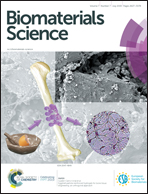Sugar-powered nanoantimicrobials for combating bacterial biofilms†
Abstract
Bacterial biofilms cause chronic infections due to their inherent tolerance to antimicrobial therapies. We describe and compare the efficacy of two types of sugar (D-glucose and D-mannose)-modified cyclodextrin nanocarriers (CD-GLU and CD-MAN) loaded with antibacterial agents for preventing and eradicating bacterial biofilm. The antibacterial agents comprise a quorum sensing inhibitor (5,6-dimethyl-2-aminobenzimidazole, DMABI) and two antibiotics (erythromycin and rifampicin), and the cyclodextrin nanocarriers were tested on Pseudomonas aeruginosa (Gram-negative) and Staphylococcus aureus (Gram-positive). DMABI loaded in the CD-GLU carrier was significantly more effective at inhibiting the development of Pseudomonas aeruginosa biofilm when compared to either its free form or when it is loaded in CD without grafted sugar moieties. Antibiotics loaded in CD-GLU and CD-MAN carriers were similarly more effective at dispersing pre-formed Pseudomonas aeruginosa biofilms. These antibacterial compounds loaded in the CD-GLU and CD-MAN carriers were somewhat less effective in eradicating Staphylococcus aureus biofilm as compared to Pseudomonas aeruginosa biofilm. This difference is attributed to the different extent of penetration of the sugar-grafted carriers into the biofilms of these two species of bacterial cells. Although the sugar-grafted carrier-antibacterial agent complexes exhibit potent effects against bacterial biofilms, they are not cytotoxic to mammalian cells.



 Please wait while we load your content...
Please wait while we load your content...